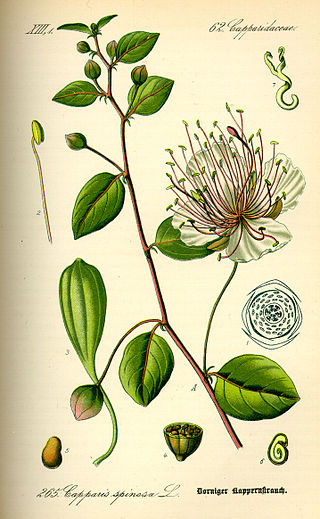
Capparis spinosa, the caper bush, also called Flinders rose, is a perennial plant that bears rounded, fleshy leaves and large white to pinkish-white flowers.
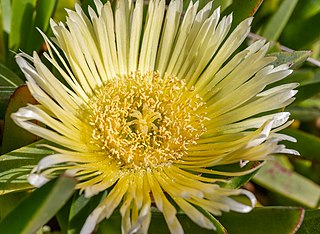
Carpobrotus edulis is a ground-creeping plant with succulent leaves in the genus Carpobrotus, native to South Africa. Its common names include hottentot-fig, sour fig, ice plant or highway ice plant.

Ceratiola is a genus of flowering plants with a single species, Ceratiola ericoides, the sand heath, sandhill-rosemary or Florida-rosemary, is a species of shrub endemic to the Southeastern United States.

The leopard tortoise is a large and attractively marked tortoise found in the savannas of eastern and southern Africa, from Sudan to the southern Cape Province. It is the only extant member of the genus Stigmochelys, although in the past, it was commonly placed in Geochelone. This tortoise is a grazing species that favors semiarid, thorny to grassland habitats. In both very hot and very cold weather, it may dwell in abandoned fox, jackal, or aardvark burrows. The leopard tortoise does not dig other than to make nests in which to lay eggs. Given its propensity for grassland habitats, it grazes extensively upon mixed grasses. It also favors succulents and thistles.
Christmasberry can refer to any one of several shrubs or small trees, as well as their colorful fruit:

Kunzea ericoides, commonly known as kānuka, kanuka, or white tea-tree, is a tree or shrub in the myrtle family, Myrtaceae and is endemic to New Zealand. It has white or pink flowers similar to those of Leptospermum and from its first formal description in 1832 until 1983 was known as Leptospermum ericoides. The flowers have five petals and up to 25 stamens which are mostly longer than the petals.

Ammophila arenaria is a species of grass in the family Poaceae. It is known by the common names marram grass and European beachgrass. It is one of two species of the genus Ammophila. It is native to the coastlines of Europe and North Africa where it grows in the sands of beach dunes. It is a perennial grass forming stiff, hardy clumps of erect stems up to 1.2 metres (3.9 ft) in height. It grows from a network of thick rhizomes which give it a sturdy anchor in its sand substrate and allow it to spread upward as sand accumulates. These rhizomes can grow laterally by 2 metres in six months. One clump can produce 100 new shoots annually.

Juniperus phoenicea, the Phoenicean juniper or Arâr, is a juniper found throughout the Mediterranean region.
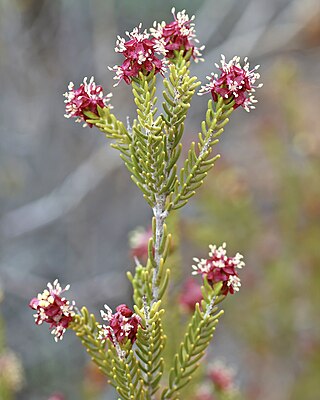
Passerina is a genus in the plant family Thymelaeaceae. They are ericoid bushes growing largely in fynbos and other Southern African scrub habitats.

Florida sand pine scrub is an endangered subtropical forest ecoregion found throughout Florida in the United States. It is found on coastal and inland sand ridges and is characterized by an evergreen xeromorphic plant community dominated by shrubs and dwarf oaks. Because the low-nutrient sandy soils do not retain moisture, the ecosystem is effectively an arid one. Wildfires infrequently occur in the Florida scrub. Most of the annual rainfall falls in summer. It is endangered by residential, commercial and agricultural development, with the largest remaining block in and around the Ocala National Forest. Lake Wales Ridge National Wildlife Refuge also holds a high proportion of remaining scrub habitat, while the Archbold Biological Station near Lake Placid contains about 20 km2 (7.7 sq mi) of scrub habitat and sponsors biological research on it.

Ericameria ericoides, known by the common names California goldenbush, mock heather, and California heathgoldenrod, is a species of flowering shrubs in the family Asteraceae. It is endemic to California, where it grows in the sand dunes and coastal hills between the northern San Francisco Bay Area and the Los Angeles area.

The angulate tortoise is a species of tortoise found in dry areas and coastal scrub vegetation in South Africa. This tortoise is the only known member of the genus Chersina.

Southern African Sand Forest is a sand forest, or a subtropical forest plant community of the tropical and subtropical dry broadleaf forests biome. It grows on ancient sand dunes in northern KwaZulu-Natal and southern Mozambique. In South Africa these forests are known simply as Sand Forest, while in Mozambique they are known as Licuati Forest. The Southern African sand forest is part of the Maputaland coastal forest mosaic ecoregion.
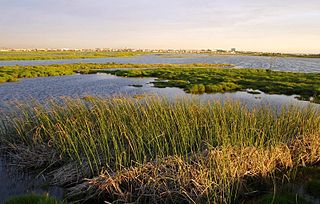
The Rietvlei Wetland Reserve is a 663-hectare (1,640-acre) nature reserve situated in Table View, Western Cape, South Africa. It is managed by the City of Cape Town's Environmental Resource Management Department.

Osyris compressa is a facultatively hemiparasitic, mainly South African plant of the sandalwood family, Santalaceae. Until recently, the favoured binomial name was Colpoon compressum, but around 2001, the genus Colpoon was included in Osyris on the basis of comparative DNA studies. That assignment is not final, however, and according to the Kew Gardens plant list, Colpoon compressum P.J.Bergius, though still in review, is the accepted name.

Macassar Dunes Conservation Area is a 1,116-hectare (2,760-acre) coastal nature reserve in Macassar, within the City of Cape Town, South Africa.

Arctotheca populifolia is a species of flowering plant in the family Asteraceae known by the common names beach daisy, Cape beach daisy, South African beach daisy, coast capeweed, dune arctotheca, beach pumpkin, sea pumpkin, dune cabbage, and in South Africa, seepampoen, tonteldoek, and strandgousblom. This species is native to South Africa. It was introduced to Australia and is now a common weed of coastal areas in New South Wales, South Australia, Tasmania, Victoria, and Western Australia.
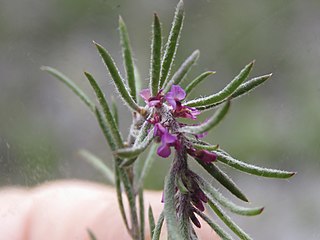
Muraltia is a genus of plants in the milkwort family (Polygalaceae) which is native to Southern and Eastern Africa. Most of the species are endemic to South Africa, and one species is naturalized in Australia. It is named after Johannes von Muralt, a Swiss botanist and surgeon.

Chironia baccifera, known as Christmas berry, bitterbossie or aambeibessie, is species of Chironia native to southern South Africa. A bushy shrub, it can reach 1 m, but is typically 0.5 m in width and height. Its Afrikaans name aambeibessie refers to its supposed medicinal use in treating haemorrhoids. It is used as an ornamental, preferring sandy soils. It is mildly toxic.


















